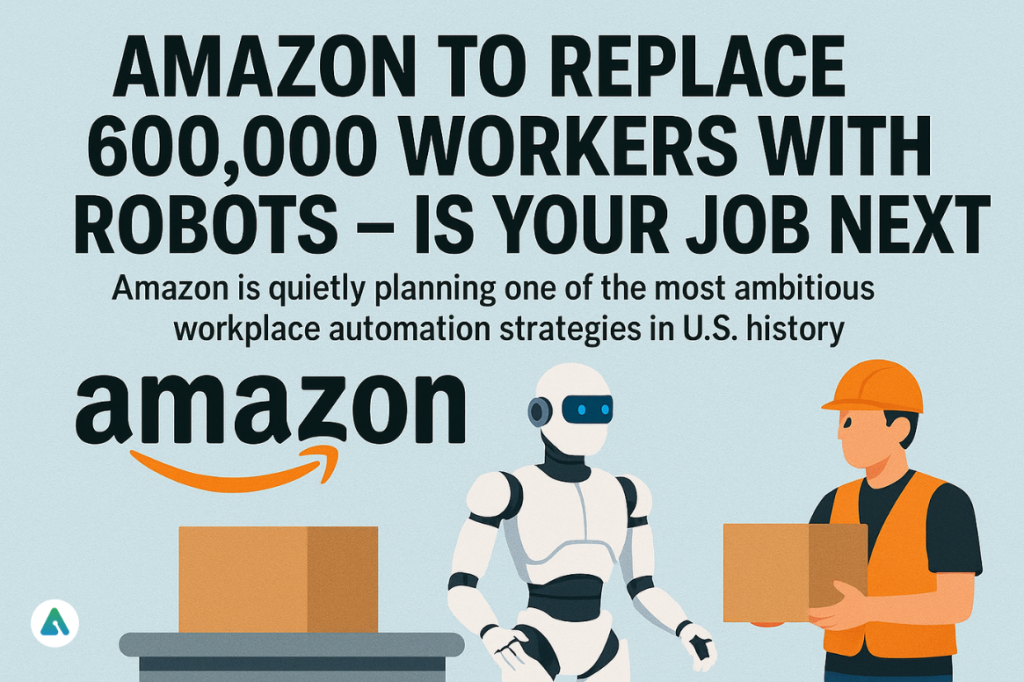Amazon is quietly planning one of the most ambitious workplace automation strategies in U.S. history. Internal documents reviewed by The New York Times reveal that the e-commerce giant Amazon could replace more than 600,000 U.S. workers with robots by 2033, even as the company expects to double its product sales over the next decade.
The numbers are striking. By automating roughly 75% of its operations, Amazon could eliminate 160,000 jobs by 2027, cutting about 30 cents from the cost of every item processed and saving the company $12.6 billion between 2025 and 2027.
Robots on the Warehouse Floor
Amazon’s warehouses are increasingly dominated by robots designed to handle tasks that once required human dexterity. In Shreveport, Louisiana, robotic systems like Sparrow, Robin, Cardinal, and Proteus now pick items, sort packages, stack boxes, and even transport carts to shippin docks. The bipedal Digit bots are also being tested to navigate more complex environments.
- Sparrow: Picks individual items from bins and transfers them.
- Robin: Loads packed items onto the shuttle robot Pegasus, which sorts packages.
- Cardinal: Efficiently stacks boxes into carts for shipping.
- Proteus: Moves carts to shipping areas, avoiding workers along the way.
The new Sequoia system replaces old cubby storage with robot-friendly plastic bins. Using computer vision, machines can identify and move items quickly, leaving humans to only a few manual touchpoints, like unpacking and bin placement.
The AI Brain Behind the Bots
Amazon is not stopping at mechanical automation. Advanced AI from startups like Covariant gives robots the ability to “think”—deciding which items to pick, where to place them, and how to move efficiently. Upcoming robotic models, Bluejay and Starling, are expected to handle a broader range of tasks in different warehouse layouts.
Economic and Social Consequences
Experts warn the implications extend beyond Amazon. Nobel laureate Daron Acemoglu told The New York Times: “Once Amazon figures out how to automate profitably, others will follow. One of the biggest employers in the U.S. could become a net job destroyer, not a net job creator.”
Some reports have raised broader concerns about AI and automation risks across the U.S. workforce. According to Sanders, AI could jeopardize 100 million jobs, yet experts argue the true number is likely smaller.
Amazon is reportedly aware of potential backlash. Leaked documents show executives considered a PR strategy to soften the message, using phrases like “advanced technology” or “cobots” instead of “AI” or “automation,” and exploring community programs to highlight social responsibility.
The Bigger Picture
With over a million robots already in action, Amazon’s automation plans show a future where human labor focuses on oversight and exception handling, while robots perform repetitive, high-precision tasks. Furthermore, Amazon move to replace 600,000 workers with robots signals a trend that competitors across retail and logistics may follow, reshaping the U.S. labor market.
For Amazon’s 1.5 million employees, the message is clear: automation is coming fast. The company has historically created jobs as it grew, but this plan explicitly aims to increase output while reducing headcount, signaling a major shift in how work—and robots—will coexist in American warehouses.
Visit: AIInsightsNews


